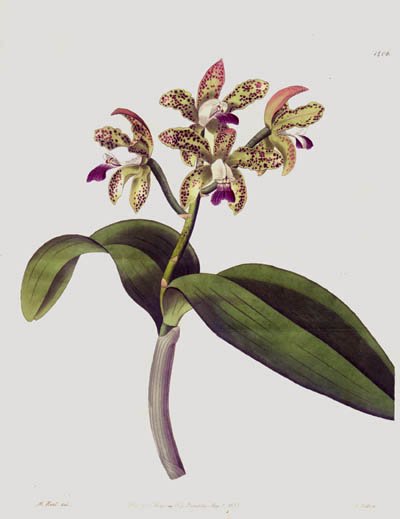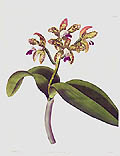| Title: |
Spotted Cattleya, or, Cattleya Guttata, Orchid (Floral Study for 'Edwards's Botanical Register', or, Ornamental flower-garden and shrubbery) |
| Engraver: |
Watts, J (British, 19th c.) |
| Designer: |
Hart, M. (British, 19th c.) |
| Date: |
1831 |
| Medium: |
Original Hand - Coloured Etching |
| Publisher: |
J. Ridgway, London |
| Editor: |
Sydenham Edwards, London |
| Note: |
The 19th Century Botanical Engravers: J.
Watts was one of the principal British etchers who produced original
etchings and engravings after M. Hart's designs for The Botanical
Register and Edward's Botanical Register. Unfortunately, not much information
is available on many of the 19th century botanical artists because their
works were primarily created for scientific and educational purposes.
Nevertheless, these etchings were so specialized and meticulous that
they have left behind some of the finest records and portrayals of the
19th century floral world. We have now come to regard these engravings
as wonderful works of early botanical art. Dated 1831, this original etching depicts
the Cattleya Guttata also known as the Spotted Cattleya Orchid. It hails from
'Edwards's Botanical Register', or, Ornamental flower-garden and shrubbery), edited
by the famous English botanist, John Lindley (1799-1865), professor of Botany at
the University of London, pl 1406, vol. 17. |
| |
The Botanical Magazine or Flower Garden Displayed
was founded by William Curtis (1746-99) and in 1787 was published semi-annually
in London. It was the first periodical to provide gardeners with important
horticultural information and its quick acceptance by the public inspired
half a dozen other magazines by the beginning of the nineteenth century.
Along with William Kilburn, James Sowerby and Walter Fitch, Sydenham Edwards
was one of the principal artists. |
| |
Some of the greatest botanical engravings of the early nineteenth
century were commissioned for a periodical entitled The Botanical Register. It
was published in London by James Ridgeway and edited by the famous botanist,
Sydenham Teak Edwards (1769 - 1819) who produced many of the engravings
and drawings for Curtis' Botanical Magazine until 1815 when Edwards
decided to publish his own monthly magazine. |
| |
From its inception in 1815 to the year 1828 The Botanical
Register published superb botanical engravings for each issue. All
were delicately coloured by hired artists and the larger plates (such as
this original example of the spotted cattleya orchid) were folded into the text. The magazine was continued
as Edward's Botanical Register from 1828 to 1847. After 1847 the
engravings became too expensive to produce and were replaced with lithographs. |
| |
What makes these early and original works of floral art from
Edward's Botanical Register so desirable should be obvious at first
glance. The engraving is both artistic and accurate and the hand-colouring
that was so long ago applied is unparalleled in its subtle ranges of hues
and tones. An original engraving such as this example of the spotted
cattleya orchid simply ranks among the finest botanical art one may acquire. |
| |
Cattleya Guttata: The Cattleya Guttata,
also known as the Spotted Cattleya Orchid, belongs to the Orchidaceae (Orchid)
family and the subfamily of the Epidendroideae. An article by (J.L.),
John Lindley, the English botanist in Edwards's Botanical Register
thanks the Right Honorable Robert Gordon, for sending this flower along
with other interesting plants from Brazil. His remarks concerning the
flower depicted in this original hand-colored etching partially reads; "The spotting of the flower is remarkably
different from any thing that has yet been seen in the same genus" *
James Ridgway, London, "Edwards's Botanical Register", pl 1406, Vol. 17. The genus was named
by John Lindley after Sir William Cattely. The Cattleya guttata is a
native species of Southern Brazil. As can be seen in this etching, the color of the flower varies from greenish
yellow to reddish brown with spotting on the segments. The lip is lavender
with white to lavender variations in color on the side lobes.
There are many varieties of Cattleya and an increasing number of hybrids,
their color and size varies considerably as does their beauty. |
| Source: |
Edwards's Botanical Register |
| Size: |
10 X 8 (Sizes in inches are approximate, height preceding
width of plate-mark or image.) |
| |
Framed and Matted with 100% Archival Materials |
| |
View larger Framed Image |
| |
 |
| Condition: |
Printed upon nineteenth century wove paper and with full margins
as published in London and dated 1831. Containing the horizontal fold
marks, as usual, else a strong impression with fine hand-colouring and in
excellent condition throughout. This original engraving from Edwards's Botanical Register
represents a prime example of early nineteenth century floral art. |
| Price: |
Sold - The price is no longer available. |
| Important Information: |
The artist biographies, research and or information pertaining to all the original works of art posted on our pages has been written and designed by Greg & Connie Peters exclusively for our site, (www.artoftheprint.com). Please visit us regularly to view the latest artworks offered for sale. We will soon be posting an update of our most recent research and include the biographical and historical information pertaining to our next collection of original works of art created by artists throughout the centuries. We hope you found the information you were looking for and that it has been beneficial.
Our Gallery, (Art of the Print / www.artoftheprint.com) guarantees the authenticity of every work of art we sell 100%. Full documentation and certification is provided. We offer a wide selection of international fine art dating from the early Renaissance to the contemporary art period. |












![]()
![]() or
phone Greg & Connie (905) 957-6666
or
phone Greg & Connie (905) 957-6666